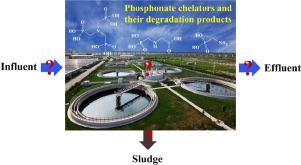Water Research ( IF 11.4 ) Pub Date : 2020-07-12 , DOI: 10.1016/j.watres.2020.116173 Shu Wang 1 , Bingliang Zhang 1 , Chao Shan 1 , Xing Yan 1 , Hong Chen 2 , Bingcai Pan 1

|
Phosphonates discharged from wastewater treatment plants (WWTPs) have attracted increasing concerns because of their potential impact on eutrophication and potential risks to aquatic ecosystems. However, very few studies are available on their occurrence and transformation in WWTPs, partly due to the lack of sensitive methods for phosphonate analysis in complex matrices. Herein, based on our recent progress in phosphonate analysis, the occurrence and transformation of phosphonates along the full-scale wastewater treatment processes of two textile dyeing WWTPs were revealed. A set of typical phosphonates, including six phosphonate chelators (PCs) and four potential degradation products of PCs (DP-PCs) were quantified in different units and the final dewatered sludge. Three PCs (2-phosphonobutane-1,2,4-tricarboxylic acid (PBTC), 1-hydroxyethane 1,1-diphosphonic acid (HEDP) and nitrilotris(methylene phosphonic acid) (NTMP)) at upmost mg/L and a considerable amount of four DP-PCs (9.12–608 μg/L) were detected in the influents of both WWTPs. In the subsequent treatment, NTMP could be removed more efficiently than PBTC and HEDP, especially in the coagulation unit, and the dissolved phosphonates were eliminated more readily than other dissolved organic phosphorus fractions. Of particular note, the toxicologically critical DP-PC (i.e., aminomethylphosphonic acid) was produced during the coagulation and biological treatment units. The final precipitation unit seemed essential to ensure satisfactory removal of PCs and DP-PCs. In addition, a significant accumulation of phosphonates in dewatered sludge (up to 7.81 g/kg) and the widespread occurrence of harmful DP-PCs also reminded us to pay more concerns on their potential risks during further sludge disposal in future.
中文翻译:

纺织印染废水中膦酸盐的发生和转化是通过全面联合处理过程进行的。
从废水处理厂(WWTP)排放的膦酸盐由于对富营养化的潜在影响以及对水生生态系统的潜在风险而引起了越来越多的关注。但是,关于废水处理厂中废水的发生和转化的研究很少,部分是由于缺乏用于复杂基质中膦酸盐分析的灵敏方法。在此,根据我们最近在膦酸酯分析中的进展,揭示了膦酸酯在两个纺织印染废水处理厂的全面废水处理过程中的发生和转化。一组典型的膦酸酯,包括六个膦酸酯螯合剂(PC)和四个PC潜在降解产物(DP-PC),以不同的单位和最终的脱水污泥进行了定量。三台PC(2-膦酰基丁烷-1,2,4-三羧酸(PBTC),1-羟基乙烷1,在两个污水处理厂的进水口均检测到最高浓度为mg / L的1-二膦酸(HEDP)和次氮基(亚甲基膦酸)(NTMP),以及大量的四台DP-PC(9.12-608μg/ L)。在随后的处理中,与PBTC和HEDP相比,NTMP去除效率更高,尤其是在混凝装置中,并且与其他溶解的有机磷馏分相比,更容易消除溶解的膦酸酯。特别值得注意的是,在混凝和生物处理单元中产生了毒理学上至关重要的DP-PC(即氨基甲基膦酸)。最终的沉淀装置似乎对于确保令人满意地去除PC和DP-PC至关重要。此外,脱水污泥中大量的膦酸酯积累(最多7个)。











































 京公网安备 11010802027423号
京公网安备 11010802027423号